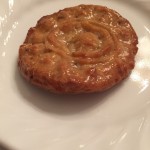“Ok so some of our um, uh traditions at Easter time in the Karam family where I grew up, and the Karam family is of uh, actually Syrian descent, and our family was Marinite Catholic and so we um followed Christian holidays and traditions. Ok so, a holiday tradition is to make a sweet bread called “ka’ik”(pronounced ka-yak) at Easter time, and my mother in law, used to always make it, and its like a dense biscuit, almost like a scone, and it has anise in it, which is sort of like the same flavor that licorice comes from, and she had a mold she would press it in before she baked it and they were kind of circular shape with an imprinted design on top, and then when they came out of the oven, she would pour just like a sugar water over it, I don’t think it had rosewater in it like the baklava, and uh so anyway we always had those at Easter time.”
Informant: The informant is a Catholic mother of five, of Syrian descent. She is from Kinder, Louisiana, where she grew up in a large family.
Analysis:
The context of this traditional food exemplifies the Catholic practices of this family that is of Syrian/Lebanese descent. Because they follow the Catholic Church, they celebrate the traditional Christian holidays. Cooking for these holidays is an important aspect of the performance of folklore, because most of the recipes are passed down from through the women of the households. The informant learned of this recipe through cooking with her mother-in law, demonstrating the close and important familial ties of this culture.
The significance of this dish is that it comes from Syrian/Lebanese styles of cooking, which is exemplified through the use of anise in the recipe. Anise can be found in the Mediterranean region, and is a spice commonly used in dishes that are derived from this region. This exhibits how baking, cooking, and sharing recipes with family members is an integral part of sharing culture. As the informant also stated that she felt it was her duty to teach her children how to cook the family recipes in order to continue the customs of her traditional culture, it is apparent that recipes like this carry a special significance.
I agree that this significance is the importance of passing down traditional practices through the kitchen as a way of extenuating one’s culture. I also think it is interesting how the women are the ones baking and cooking together. I believe that this comes from the Catholic/Christian influence in the family. Because the Abrahamic tradition is patrilineal, it is apparent that the women have traditionally been the ones in the home doing the cooking for many generations. This continues to be the case as recipes are handed down from matriarch to matriarch.

